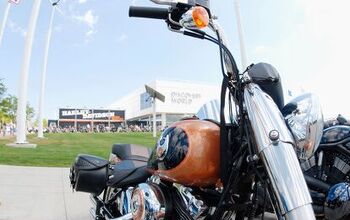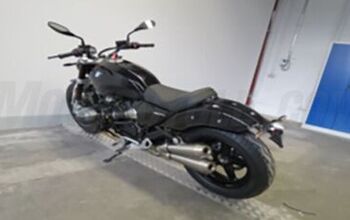Getting Started at the Strip
Faster reaction times when the lights change let the tortoise beat the hare.
What you'll need to go street class racing: A set of racing leathers, (leather jacket and pants are still approved in some sanctions) full-face Snell 85 or 90 approved helmet, boots, gloves, and one Harley Davidson V-twin motorcycle, Sportster or Big Twin. Most stock class entrants are on Evolution-era motorcycles now (because of their reliability) although you can probably race your knucklehead if you want to. Stock classes are usually just that, sometimes with modifications to exhaust or carburetion allowed -- call the sanctioning body for rules. Some events require a lanyard kill switch (dead man's switch), that can be bought for a few dollars. Expect to pay a few bucks for a rulebook (essential reading), a few more bucks for numberplates, and up to 50 dollars in entry fees, depending on class. You may have to stump up a tech fee too, and you'll have to submit to a tech inspection; no oil leaks allowed.
Remember, victory doesn't always go to the quickest, or the fastest, rather to the first one past the timing post at the end of the strip.
Most sanctions run practice, then qualifying. In two-day events, practice is a rather leisurely affair, and you may get as many runs as you can stand. One day events are more hurried, and practice may be limited to just a couple of runs, followed by qualifying, lunch break (bring fast food, you'll be busy making those last few adjustments) and the main event. If your qualifying time is good enough, you'll be paired up on "the ladder". Beat your opponent, and you climb the ladder, lose and you're a spectator. Remember, victory doesn't always go to the quickest, or the fastest, rather to the first one past the timing post at the end of the strip. Since the winner in a drag race is the one who reaches the line first, faster reaction times when the lights change lets the tortoise beat the hare.
The ritual: You and your opponent approach the staging area. A few feet before the line, there's a water-soaked patch to burnout the back tire. Rev the bike, let out the clutch (second gear works best for burnouts) and spin the wheel until the tire smokes (how much you let it smoke depends on how often you like to replace it). This warms the tire to get the best grip from the line. Next, the short hop: a practice start to get the feel of the tire/track combination.
Lean forward on the bike to keep weight forward and the front wheel down: Be prepared to lean back to help traction if the rear tire starts to spin.
Then the psychology starts. As you move close to the start line, the front wheel breaks a beam that lights the top bulb on the Christmas tree you're pre staged. Rev the engine to launch rpm and paddle forward. An inch or so further (no more, or the first light will go out) and you're staged. Once both bikes are staged, the starter may hit the button at any time. Here's the butterflies bit: Your opponent may delay his staging until you look at him, or you close the throttle slightly to keep the engine from overheating. Ignore him.Lean forward on the bike to keep weight forward and the front wheel down: Be prepared to lean back to help traction if the rear tire starts to spin.
When the starter hits the button, the three yellows blink down from the top of the Christmas tree like a '68 mercury Cougar's turn signals, followed 0.4 seconds later by the green. A good racer will be yanking the throttle and letting go of the clutch before the light turns green: But don't rush it, leave too soon and the red light will disqualify you.
Pros leave the line with front wheel pawing six inches in the air, rear tire wrinkled from its unequal contest with the ground, wheelie bar well dug in. You don't have to be that spectacular.
...fast riders don't watch the tack at all, rather, they listen to the engine and shift by its sound and vibration.
The key is to balance the traction equation: Too much traction off the line whips the front end up, and can bog the motor even if the rider doesn't back off, but too much wheelspin loses time and wastes power until the tire hooks up again and can let the bike fishtail off line. The launch is critical: Once underway, keeping your body out of the breeze and changing gear at the right time is all that requires concentration. Changing gears isn't as simple as watching the tachometer for redline -- fast riders don't watch the tack at all, rather, they listen to the engine and shift by its sound and vibration. As the motor comes off peak, you'll hear and feel a subtle change in the motor -- that's when you shift. It takes some practice, but we've found it to be worth about 0.2 seconds in the quarter mile. The run is over as you pass the lights.
Drag racing's easier to learn than road racing or enduros, but it'll probably take a dozen or more runs until you get a feel for the sport.
Your local dragstrip may have grudge nights, when anybody can compete against the clock, with consistency rather than speed the key, or contact the all-Harley Organizations. East Coast Racing Association (ECRA) (609) 652 1159, American Motorcycle Racing Association AMRA Box 50, Itasca, Il 60143, All Harley Drag Racing Association AHDRA (910) 229 4877
More by Andy Saunders



























Comments
Join the conversation